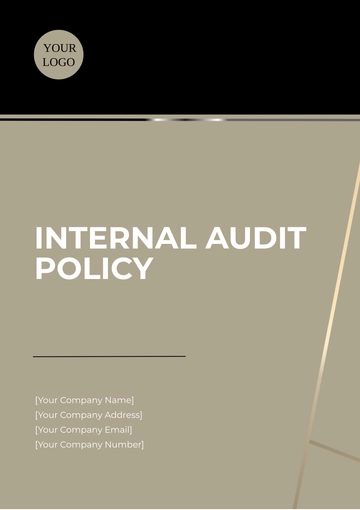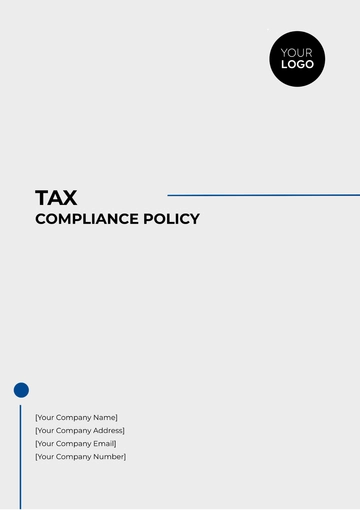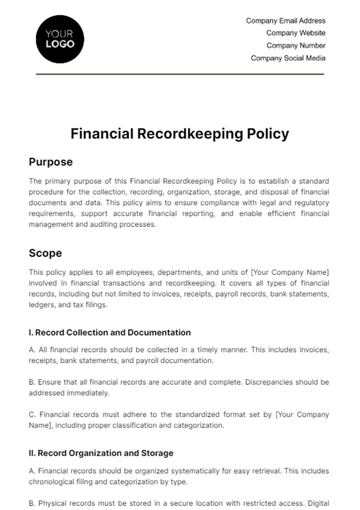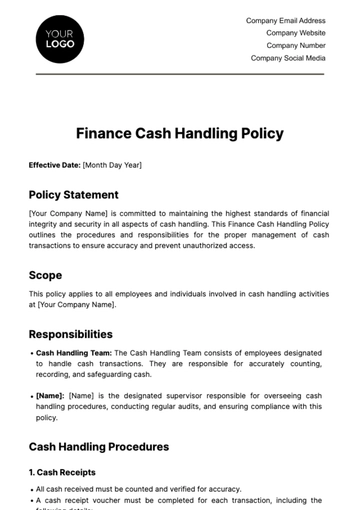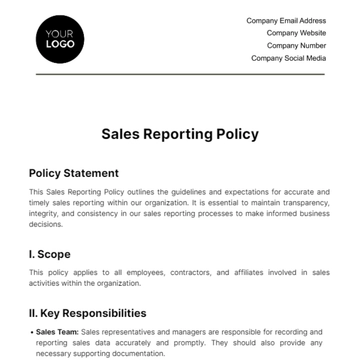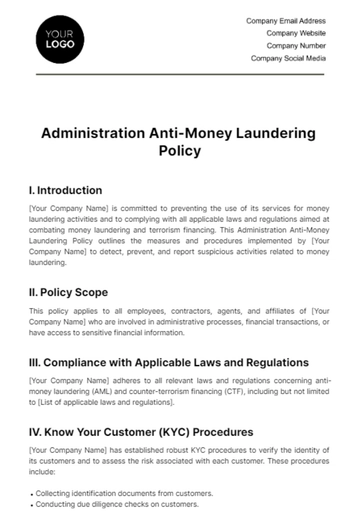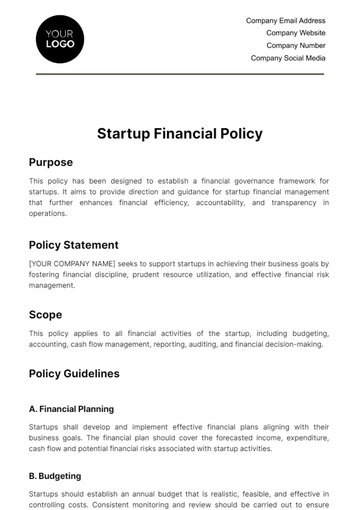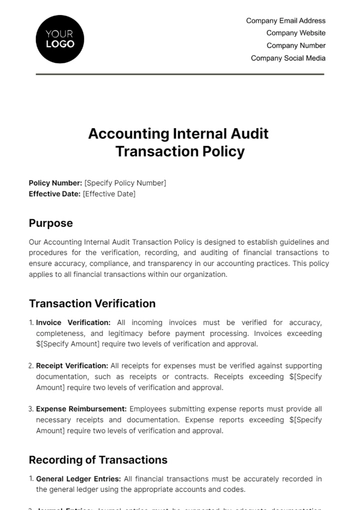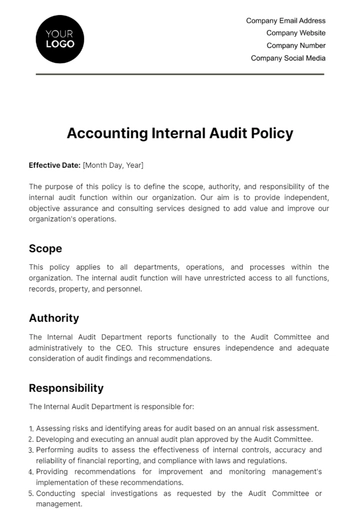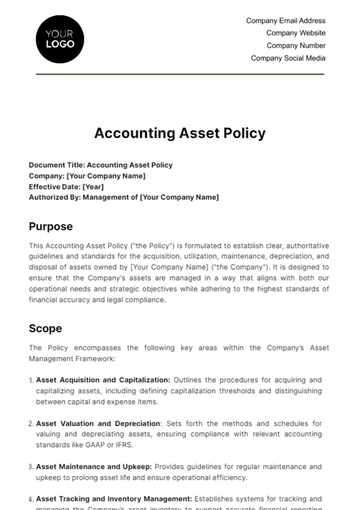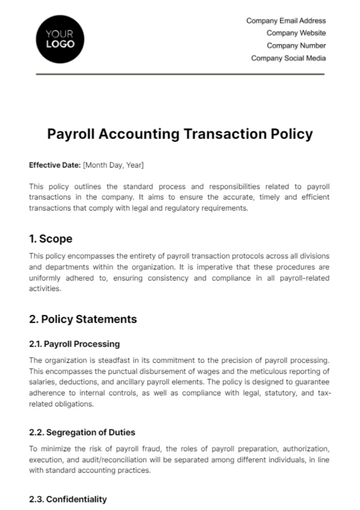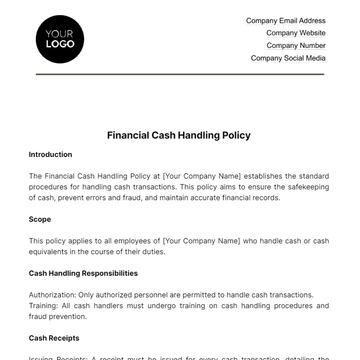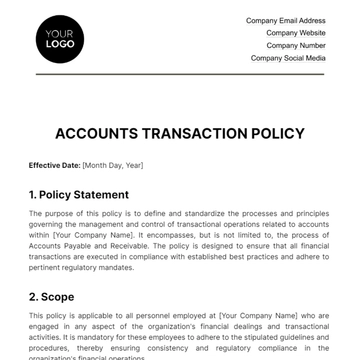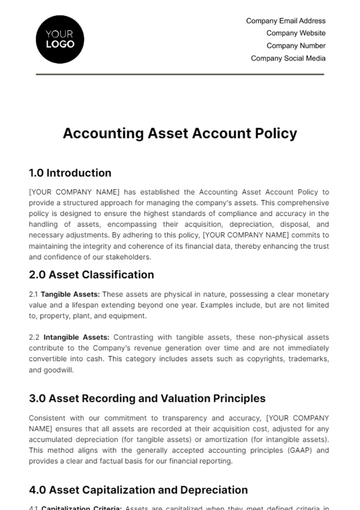Free Financial Policy Brief
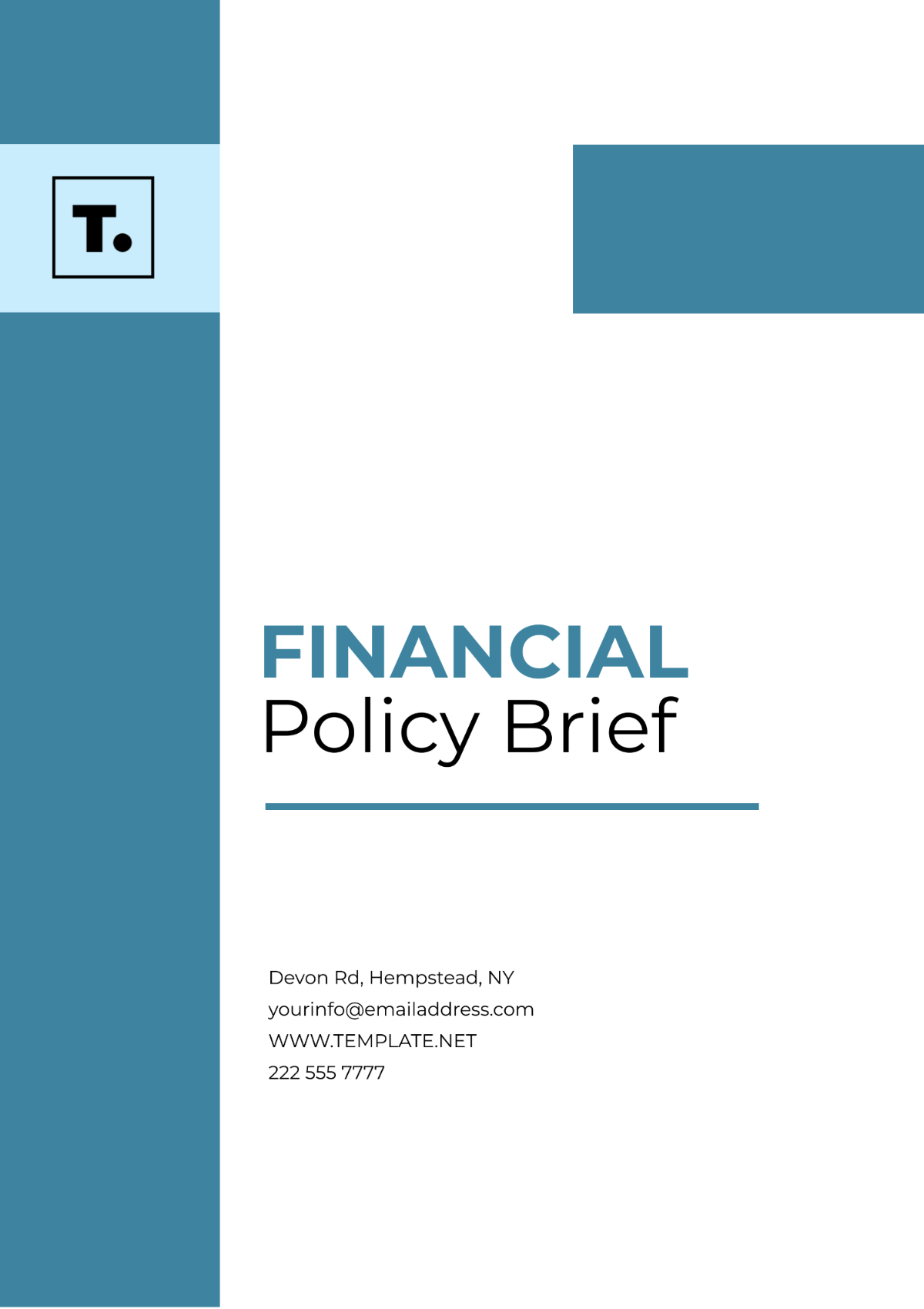
Prepared By: [YOUR NAME]
Company: [YOUR COMPANY NAME]
Introduction
This financial policy brief provides an inclusive overview of the financial guidelines concerning decision-making, governance, and compliance within [YOUR COMPANY NAME]. Our financial management strategy encompasses areas such as budgeting, accounting, cash management, investments, and financial reporting.
Budgeting
Budgeting is a crucial aspect of financial management that enables organizations to allocate resources effectively, achieve financial goals, and ensure accountability. Here's a breakdown of the key components:
Annual Budget Planning Process:
The annual budget planning process typically begins with setting financial goals and objectives for the upcoming fiscal year.
Departments or units within the organization submit budget proposals outlining their projected expenses and revenue expectations.
These proposals are reviewed by budget committees or finance teams, which assess their alignment with organizational objectives and overall financial feasibility.
Negotiations may occur to reconcile competing priorities and optimize resource allocation.
Once finalized, the budget is approved by senior management or the board of directors before implementation.
Roles and Responsibilities of Budget Holders:
Budget holders are individuals or teams responsible for managing specific budgets within [YOUR COMPANY NAME].
Their roles typically include:
Developing detailed budget plans based on organizational goals and guidelines.
Monitoring actual spending against budgeted amounts and taking corrective action when necessary.
Communicating budgetary constraints and variances to relevant stakeholders.
Collaborating with other departments to ensure efficient use of resources and alignment with overall objectives.
Providing input for budget revisions and adjustments based on changing circumstances or priorities.
Monitoring and Reporting of Budget Variances:
Regular monitoring of budget variances is essential to track financial performance and identify potential issues.
Budget holders compare actual expenses and revenues with budgeted amounts to assess variances.
Variances may be categorized as favorable (spending less than budgeted) or unfavorable (spending more than budgeted).
Reports detailing variances, their causes, and proposed actions are prepared and submitted to management or relevant stakeholders periodically.
Analysis of variances helps identify trends, inefficiencies, or opportunities for improvement and informs decision-making processes.
Procedures for Budget Revisions and Approvals:
Budget revisions may be necessary due to changes in market conditions, strategic priorities, or unforeseen events.
Proposed revisions are typically reviewed by finance teams or budget committees to assess their impact on overall financial health and alignment with organizational objectives.
Approval processes vary but often involve senior management or the board of directors.
Once approved, revised budgets are communicated to relevant stakeholders, and adjustments are implemented accordingly.
Accounting
Our accounting policies resonate with national and international accounting standards and reflect transparency and accountability.
Aspect | Description |
|---|---|
Accounting Policies | Aligned with national and international standards for transparency and accountability. |
Financial Transaction Recording | Accurately record all business activities using double-entry bookkeeping. |
Regular Financial Audits | Conduct systematic reviews to ensure the accuracy, compliance, and integrity of financial records. |
Vendor Payments and Invoicing | Manage payments to suppliers, verify invoices, and maintain documentation for audit purposes. |
Revenue Recognition | Recognize revenue when earned and reconcile cash inflows to ensure accurate financial reporting. |
Cash Management
Cash management is a crucial aspect of financial management for any organization, ensuring optimal utilization of cash resources while minimizing risks. Here's a breakdown of specific strategies and practices involved in effective cash management:
Cash Flow Forecasting and Planning:
Regularly forecast cash inflows and outflows to anticipate liquidity needs.
Utilize historical data, sales projections, and expense forecasts to create accurate cash flow projections.
Adjust forecasts regularly based on changes in market conditions, business operations, and economic factors.
Investment of Surplus Cash:
Identify surplus cash that is not immediately needed for operations.
Evaluate various investment options such as short-term investments, money market funds, or term deposits to earn returns on idle cash.
Balance the need for liquidity with the desire for higher returns by diversifying investment portfolios.
Cash Handling and Banking Arrangements:
Establish clear procedures for cash handling to prevent theft or misappropriation.
Maintain strong relationships with banks to leverage services such as cash pooling, automated clearing house (ACH) transfers, and electronic funds transfers (EFTs).
Negotiate favorable terms and fees with banks to optimize banking arrangements.
Controls Over Payments and Withdrawals:
Implement robust approval processes for payments and withdrawals to prevent fraud or unauthorized transactions.
Utilize dual controls or segregation of duties to ensure proper authorization and verification of transactions.
Regularly reconcile bank statements with internal records to detect discrepancies and errors promptly.
Safekeeping of Cheques, Cash, and Other Valuable Documents:
Store physical cash, cheques, and valuable documents securely in safes or vaults.
Limit access to authorized personnel only and maintain detailed records of access and transactions.
Implement additional security measures such as surveillance cameras and alarm systems to deter theft or unauthorized access.
Technology Integration:
Utilize cash management software or treasury management systems to automate cash flow forecasting, transaction processing, and reporting.
Integrate banking systems with accounting software to streamline reconciliation and reporting processes.
Leverage electronic payment systems and online banking platforms for efficient fund transfers and bill payments.
Continuous Monitoring and Review:
Regularly monitor cash flows, liquidity positions, and investment performance against established targets and benchmarks.
Conduct periodic reviews of cash management policies and procedures to identify areas for improvement or optimization.
Stay informed about regulatory changes, market trends, and emerging technologies to adapt cash management strategies accordingly.
Investment
Our investment policies are guided by principles of risk management and long-term financial sustainability.
Portfolio Management Guidelines:
Establish clear guidelines for asset allocation, diversification, and risk tolerance.
Determine investment objectives and strategies aligned with the organization's goals and risk appetite.
Regularly review and rebalance the portfolio to maintain desired risk-return profiles.
Employ modern portfolio theory and quantitative analysis techniques to optimize investment performance.
Compliance with Investment Regulations:
Adhere to relevant laws, regulations, and industry standards governing investments.
Ensure transparency and accountability in investment practices.
Engage legal and compliance professionals to interpret and navigate complex regulatory frameworks.
Stay abreast of regulatory changes and adapt investment strategies accordingly.
Due Diligence for Investment Decisions:
Conduct thorough research and analysis of potential investment opportunities.
Evaluate financial metrics, market trends, and industry dynamics.
Assess the credibility and track record of investment managers and counterparties.
Perform risk assessments and scenario analyses to anticipate potential outcomes.
Monitoring and Reporting of Investment Returns:
Implement robust monitoring mechanisms to track the performance of investments.
Generate regular reports on investment returns, risk metrics, and compliance status.
Utilize performance attribution analysis to assess the contribution of different investment strategies and asset classes.
Communicate investment results and insights to relevant stakeholders, including senior management and the board of directors.
Financial Reporting
Our financial reporting framework ensures that stakeholders receive reliable and timely information on financial performance.
Frequency and Format of Financial Reports:
Financial reports are typically prepared on a quarterly and annual basis, although some companies may also provide monthly reports for internal purposes.
The format of financial reports often includes key statements such as the income statement, balance sheet, cash flow statement, and statement of changes in equity. These statements are prepared by generally accepted accounting principles (GAAP) or international financial reporting standards (IFRS), depending on the jurisdiction and industry standards.
Internal Financial Reporting for Management Decisions:
Internal financial reports are tailored to the needs of management and are used for making strategic decisions, evaluating performance, and managing resources effectively.
These reports may include detailed analyses of various financial metrics, budget versus actual comparisons, variance analysis, and forecasts to support planning and decision-making processes.
Internal financial reports are often more detailed and flexible compared to external reports, as they are primarily intended for internal use and can be customized to address specific management concerns or objectives.
External Reporting for Statutory Compliance and Public Accountability:
External financial reporting is aimed at fulfilling statutory requirements and providing information to external stakeholders such as investors, creditors, regulators, and the general public.
Key external financial reports include annual financial statements, which are typically audited by independent external auditors to enhance credibility and assurance.
External reporting must comply with relevant accounting standards and regulations, such as the Securities and Exchange Commission (SEC) requirements in the United States or the International Financial Reporting Standards (IFRS) for listed companies in many other parts of the world.
In addition to financial statements, external reporting may also include supplementary disclosures, such as management discussions and analysis (MD&A), footnotes to the financial statements, and other disclosures required by regulatory authorities.
Use of Technology in Financial Reporting:
Advances in technology have significantly impacted financial reporting practices, with many organizations adopting software solutions for data analysis, reporting automation, and visualization of financial information.
Enterprise resource planning (ERP) systems, business intelligence (BI) tools, and cloud-based accounting software are commonly used to streamline financial reporting processes, improve accuracy, and enhance transparency.
Technology enables real-time reporting capabilities, allowing stakeholders to access up-to-date financial information and insights whenever needed, thereby improving decision-making and responsiveness to changing business conditions.
- 100% Customizable, free editor
- Access 1 Million+ Templates, photo’s & graphics
- Download or share as a template
- Click and replace photos, graphics, text, backgrounds
- Resize, crop, AI write & more
- Access advanced editor
Introducing the Financial Policy Brief Template from Template.net: your comprehensive solution for robust financial policies. This customizable and editable template streamlines policy creation, ensuring accuracy and compliance. With our Ai Editor Tool, effortlessly tailor every detail to suit your organization's financial needs. Simplify policy development and elevate your financial governance with ease, exclusively on Template.net.
You may also like
- HR Policy
- Restaurant Policy
- Company Policy
- Accounting Policies and Procedures
- Website Policy
- Privacy Policy
- Safety Policy
- School Policy
- IT and Software Policy
- Law Firm Policy
- Construction Policy
- Interior Design Policy
- Travel Agency Policy
- Education Academic Policy
- Security Policy
- Real Estate Policy
- Expense Policy
- Software Policy

